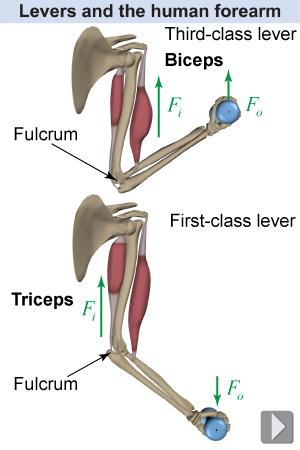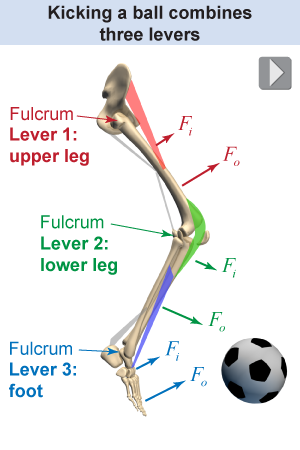|
Your body is a machine composed of many individual simple machines. When you move your limbs, your bones act as the levers, the joints are the fulcrums, the contraction of muscles provides the input forces, and the motions of your arms and legs are the output forces. Biomechanics is the study of how the body moves. 
|
 Your forearm moves up and down as a result of the contraction of two muscles in your upper arm called the biceps and triceps. When the biceps contracts, it lifts your forearm upward—pivoting about a fulcrum located within your elbow joint. The biceps attaches to the forearm at a location closer to the fulcrum than the load on the arm (such as the weight of the dumbbell shown in the figure), so the biceps acts as a third-class lever. When the triceps contracts, it causes your arm to move downward in the opposite direction. The triceps attaches to the bones on the opposite side of the elbow from the forearm, so the triceps acts as a first-class lever. The biceps and triceps must apply large input forces close to the elbow to create small output forces at the end of the arm. Your forearm has a mechanical advantage of less than one.
Your forearm moves up and down as a result of the contraction of two muscles in your upper arm called the biceps and triceps. When the biceps contracts, it lifts your forearm upward—pivoting about a fulcrum located within your elbow joint. The biceps attaches to the forearm at a location closer to the fulcrum than the load on the arm (such as the weight of the dumbbell shown in the figure), so the biceps acts as a third-class lever. When the triceps contracts, it causes your arm to move downward in the opposite direction. The triceps attaches to the bones on the opposite side of the elbow from the forearm, so the triceps acts as a first-class lever. The biceps and triceps must apply large input forces close to the elbow to create small output forces at the end of the arm. Your forearm has a mechanical advantage of less than one. 
|
Why is it useful to have an arm with MA < 1? Your arm moves through a much larger range of motion than the small motions of your muscles. Your muscles trade off force for distance—or trade off force for speed, which is distance over time. That’s why you can swing your arm around fast! 
|
 When you kick a ball, your leg acts as a combination of three levers: the upper leg pivoting about your hip joint, the lower leg pivoting about your knee, and your foot pivoting about your ankle. Each of these three lever motions is controlled by a muscle on the front of your leg. In all three cases, the input force is applied closer to the fulcrum than the output force—they are all acting as third-class levers.
When you kick a ball, your leg acts as a combination of three levers: the upper leg pivoting about your hip joint, the lower leg pivoting about your knee, and your foot pivoting about your ankle. Each of these three lever motions is controlled by a muscle on the front of your leg. In all three cases, the input force is applied closer to the fulcrum than the output force—they are all acting as third-class levers.
When you swing your leg backward while preparing to kick, your leg uses three other muscles that act in the opposite direction. Where do you think those three muscles are located? 
|
How many levers are located in one of your fingers?
 |
Your fingers each have three joints. Each joint acts as a lever, so each finger has three levers. 
|

